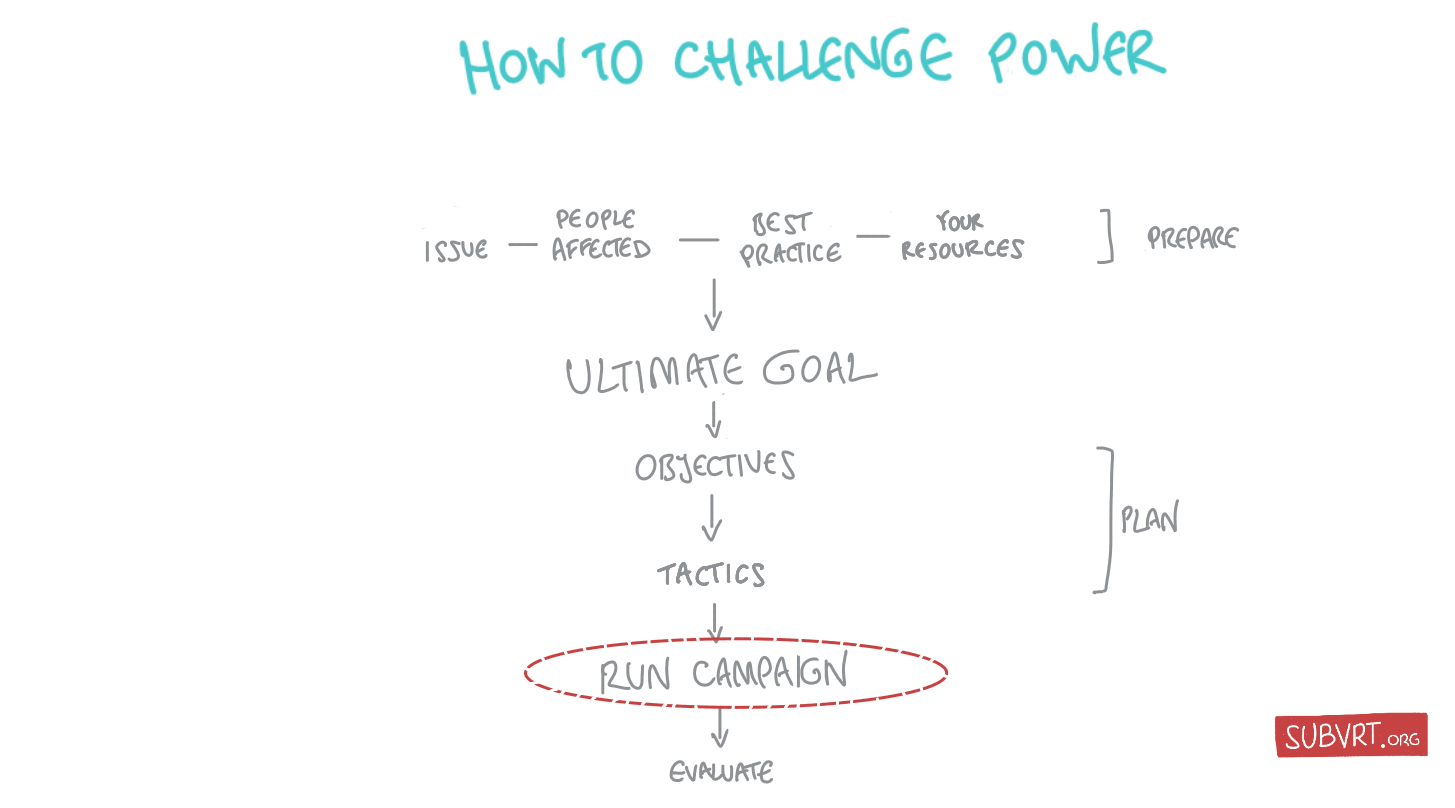A new playbook for activism
This is the process that underpins every campaign and activist project I've worked on. I developed it with Clearcase, and I’m proud to say that a range of causes and organisations across the world are actively using it make a difference.
You can use it to:
- take a stand against corporate misbehaviour
- lobby a decision-maker
- organise a protest or other action
- design a transnational campaign for all the above
- or simply to challenge power, whatever your cause, and in any context
Let's go.
Page last updated: September 2024.
The method has five steps. They spell out 'PURPLE':

- Prepare: Pick an issue, reach out to those affected, gather best practice and resources
- Ultimate goal: Draw what a world would look like with the issue resolved
- Plan: Work out how to make your ultimate goal happen, by breaking it into objectives and tactics
- Launch and run the campaign
- Evaluate it... and iterate
Actually, that doesn't spell out 'Purple'. It's OK. We were close.
Lastly, throughout this guide I'll be using examples from a campaign we ran in Portugal in 2021, to make it more concrete. If you prefer video to text, here I explain how we did the campaign, from start to finish (the text version will always have the latest though):
1. Prepare
1.1. Issue

Name your issue. Think of an injustice that outrages you, and has been doing for a while. Write it out in less than 100 words. Make sure it's:
1.1.1. Something you can influence
The main decision of any moral person is: ‘what can I influence’? That’s what should be my priority.
–Noam Chomsky
Having impact requires choosing battles you can win, and that you're motivated to work on. So pick an issue you feel passionate about, and on which you could make a difference in the short term.
This might mean focusing on only a part of a bigger issue that concerns you. Or picking something local, in your community, as opposed to something national or global.
Think Big, start small... https://t.co/aiALGs50f8
— Srdja Popovic (@SrdjaPopovic) February 3, 2022
Think it doesn't sound ambitious enough? Keeping the scope tight makes the campaign manageable. It also prevents it from collapsing under its own weight, or shooting in all directions. And you can always scale things up later, if your campaign succeeds.
1.1.2. Something expressed simply and free of jargon
Express your issue so clearly, your grandmother would get it in less than a minute. You'll be grateful for this clarity later on: to persuade others, and recruit them to your cause.
The cliffs of Ponta da Piedade in Algarve, Portugal are one of the region’s best known natural attractions. But now, a large part of this land, both public and private, has been fenced off by private interests who are seeking to develop it. This would destroy the beauty of Ponta da Piedade, and block access to public visitors.
1.1.3. Something you can back up
The best way to persuade is to seek out people who are speaking against their political interest, and draw on them as sources.
–Brendan Nyhan
Gather evidence to support your issue, like articles, statistics, studies and quotes. If you can find Establishment sources – i.e. from people who appear to be working against their interest by reporting the issue – even better.
This will help you be more persuasive. And you'll have a basis for some great campaign material later on.
1.2. People affected

Enrich your campaign with knowledge and connections from people who are experiencing the issue directly.
Let's say you’re working to push down rents in your city. Then ask for the views of tenants and owners. If you’re challenging practices in a school, invite parents onto the campaign.
To get an even better picture, vary by attributes like gender, age or education. (And yes, even if you are experiencing the issue directly, it's still valuable to have other voices.)
You decide how many people to engage, and how involved they should be. The purpose is to find the best way to tackle the issue, and give you legitimacy towards targets and potential allies.
Our campaign to save the cliffs of Ponta da Piedade in Portugal was staffed and supported by locals in the area. If private interests developed the land as our campaign was opposing, these people’s lives would change. Their perspective and connections were invaluable for the campaign.
1.3. Best practice

Someone else has likely tried to address the same issue — or a related one. Learning about what they did will inform your campaign and help you identify potential partners.
A few online searches is all it takes. What worked, what didn’t, and why? Who was involved? Capture it.
For inspiration, check the case studies section. And here's a breakdown of two campaigns I worked on.
1.4. Your resources

Before you embark on a campaign, you need to know what – and who – will be powering it. Do you have a team of people who can help? How much time could each person dedicate to the campaign per week? What other expertise do you have access to? Which partners or organisations can you connect with?
This will help you to identify gaps.
You might want to start on your own, which is fine. But if you need to build a team, get it going by holding a public brainstorm (you can also do this online). See also: skill-sets to look for, how to target people for your cause, the under-appreciated value of curiosity, avoiding the easily offended, reining in ego, and attracting working people from outside the usual activist base.
2. Ultimate goal
Express in one line how things will look when you have resolved your issue. When could stop the campaign and say "we won"? That's your ultimate goal.

Of course, your ultimate goal needs to be something that your campaign could achieve. Not something utopian. Describe the impact on the ground, on people’s lives, rather than the means to get there. Factor in the best practice you discovered, and your resources, and adjust the scope as necessary. Specify an end date. And make it as quantifiable as possible, so you can measure it later on.
Having an ultimate goal is the keystone of your campaign. It shows you what winning looks like. It gives you a fixed mission and endpoint. Without it, you’re engaging in a never-ending campaign, which will be frustrating and demotivating.
The public parts of the Ponta Da Piedade cliffs are freely accessible to all. The local community decides what happens with the land in Ponta Da Piedade that is being targeted by private interests.
3. Plan
3.1. Objectives
Break your ultimate goal into individual objectives that lead to it.

When thinking about these objectives, consider who holds the power to make your Ultimate Goal a reality. This actor is your target. Most of the objectives should relate to something this person, group or organisation needs to do.
Don’t worry about the order of the objectives. You might need to meet some of them sequentially, and some in parallel.
But make sure you can verify each objective as ‘met’ or ‘not yet met’. And that each of these objectives actually benefit the people affected.
1. The municipality removes the fences that are currently blocking the public parts of the cliffs.
2. It stops the current plans for construction or selling the land.
3. It holds a public consultation to decide collectively with the local community what will happen to the land.
Tip: Write your objectives in the active voice (note that we didn’t write ‘the fences are removed’ in the example above). And make your target the subject in each case.
3.2. Tactics
For each of your objectives, brainstorm the tactics that could achieve them.

There's no limit here on the kinds of tactics you can use. But to make it easier, consider the pressure points of the target(s) you have chosen. What would cause your targets to take notice of your demands – and ideally, act?
A typical point you can use is a target's pressure to maintain a good public image. Or their pressure to keep happy those they depend on for their power. Like their electorate, donors, appointing body or shareholders).
We asked the local community to sign an open letter with the campaign’s demands. We also reached out to influential people that lived in the area, and asked them for quotes. And delivered the whole package to the mayor with a 'handover' event.
By pressuring the mayor through engaging the local community – his electorate – we strengthened our appeal to the municipality.
Any tactic that makes progress on your objectives, and is doable with the resources you have, is worth considering. If you identified partners that could help your campaign, consider what role they could play in making these tactics happen.
And where possible, involve people affected by the issue in your tactics. As you’re designing your tactics, their advice will help you understand where you could have the most impact. But also, people who are directly affected are valuable ambassadors and spokespeople for your campaign, since they have the credibility to engage with a wide audience.
Need inspiration? Check Beautiful Trouble, Actipedia and GNAD for some case studies and suggestions. Use the best practice you researched, too. See also: strengthening your campaign material with great typography and storytelling, quick-and-dirty media skills, using creative protest, the limits of disruption, and exploiting the media's biases.
Also see how to get your first 1000 supporters for tactics to expand your base – if your campaign requires it. But consider: do you really need a mass movement to get what you want?
Once you’ve decided on a list of tactics, add standard planning info for each: single-person ownership, steps, and deadlines. Include a date when you’ve finished the tactics and can evaluate them. A never-ending campaign is a recipe for low impact.
This is your plan. Share it with your colleagues on the campaign to make everyone accountable.
Now all you have to do is hit the ‘start’ button.
4. Launch and run

This part speaks for itself.
Try to have fun with it. The cause may be serious, but the work doesn’t have to be dull.
Along the way, shout about every little success. Learn from every little failure — and adapt the plan to suit.
And if you're managing a team, the coordinated do-ocracy model can help.
5. Evaluate

It's time to be self-critical. Did your campaign have an impact?
Since you’ve described your ultimate goal and set up objectives, testing for these is straightforward. You can easily see if they were met or not.
Then, look at what the tactics brought you. Like media coverage, signatures captured, or the number of people who attended your event. How did these successes or failures contribute to achieving – or missing – your objectives and ultimate goal?
Capture your lessons learned, and factor them into future campaigns.
That’s it.
* * *
Did you get value out of this? Have feedback on it? Or need help with seeing it through? Get in touch!
And if you know someone who could could benefit from it, please share it with them.
